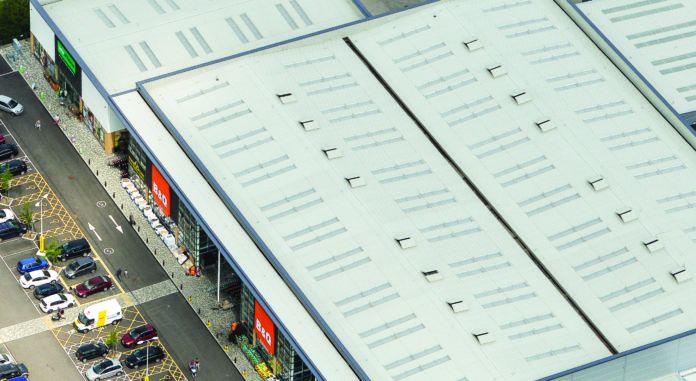The National Association of Rooflight Manufacturers (NARM) has been made aware of a number of instances where profiled Glass Reinforced Polyester (GRP) rooflights supplied for ‘in-plane’ applications, including factory and warehouse roofs, are failing to provide conformity with the UK annex to BS EN 1013: the European standard for single skin profiled rooflights.
This annex exists to ensure minimum strength characteristics for given sheet weights, to ensure non-fragile performance in accordance with the ACR test* classifications and guidance published by NARM.
Of particular concern is the fact that these rooflights therefore present a significant risk during construction and to individuals who may need to access the roof for repairs or maintenance.
GRP rooflights have been used successfully to achieve desirable levels of daylighting for over 60 years, and by their very nature, are highly durable and can safely be specified as non-fragile, providing that they have been manufactured to industry standards, to the appropriate weight, fixed to manufacturers specifications, and used in conjunction with structurally compatible roofing components.
Non-fragility of GRP rooflights, however, is a complex subject as it can be affected by a variety of factors pertaining to each specific application. Non-fragility of rooflights is classified by the ACR[M]001 “Test for Non-Fragility of Large Element Roofing Assemblies”, published by the Advisory Committee for Roofsafety (ACR).
NARM has worked closely with ACR guidelines on minimum specifications for GRP rooflights to consistently achieve non-fragility when new, and to provide a sufficient safety margin to consistently maintain non-fragility for 25 years or more, in a variety of different applications. This has been published in Technical Document NTD03 “Application of ACR[M]001 ‘Test For Non-Fragility of Large Element Roofing Assemblies’ to GRP Profiled Rooflight Sheeting.”
So, in what way are some imported rooflights failing to meet required standards?
Sheet formulation – the term ‘Glass Reinforced Polyester’ applies to a wide range of sheet formulations, with varying degrees of strength. The sheets are made up of glass strands contained within a polyester resin. It’s these reinforcing glass strands that give the sheets their strength and rigidity, hence the glass content of a sheet has an important bearing on non-fragility.
The UK annex to BS EN 1013 and NARM NTD03 both specify a minimum glass content of 33% in order for profiled rooflights to achieve the classifications used for non-fragile performance. NARM has been made aware that some imported GRP rooflights have a glass content well below this figure – often around as little as 25%.
This reduction of more than 20% of the glass reinforcement results in a significant shortfall in the strength of the product.
Use of rooflights which match the weight recommendations shown in NTD03 will not deliver the expected level of non-fragility if the glass content is significantly lower. A 2.4 kg/m2 sheet with 25% glass content will simply not achieve the same non-fragile performance as a 2.4 kg/m2 sheet with 33% glass content
Sheet thickness and weight
The weight and thickness of a GRP sheet required to achieve non-fragility varies with application, level of performance required and the period of non-fragility. Recommendations in NARM NTD03 vary between 1.8 and 3.6 kg/m2 for different applications.
It is vital that the correct weight is specified for each individual application and require a period of non-fragility. All NARM member companies can provide simple advice to ensure this.
For example, single skin sinusoidal profiled rooflights used with fibre cement sheets only need to be 2.4 kg/m2 to achieve Class C non-fragility when new, but trapezoidal profiled single rooflights (as used with metal sheets) should be a minimum of 3.0 kg/m2 to achieve non-fragility when new. However, NARM is aware that some imported trapezoidal profiled GRP rooflights are being installed significantly under this weight, at 2.4 kg/m2, and will consequently fail to achieve non-fragile performance by some margin.
Low glass content plus low weight: double the danger
The weight and glass content both have a direct correlation to the strength and non-fragile performance of GRP sheets: NARM is aware of cases where imported GRP sheets have been fitted, which are both lighter and thinner than necessary, and where the glass content is significantly lower than 33%. This will result in installations which will not be non-fragile and create a significant risk.
With falls from height accounting for the majority of construction-related deaths and injuries, this is a major cause for concern, and action must be taken to minimise this risk. Rooflight specifiers and installers should be aware of the potential risks presented by GRP rooflights that are not CE marked, do not comply with the weight and glass content requirements stipulated in the UK annex of BS EN 1013 and NTD03, or have not been tested to ACR[M]001. For this reason, when specifying GRP rooflights, documented evidence of the above should always be sought – and provided by the supplier.
Sourcing GRP rooflights from a NARM member company is a simple way to ensure safety compliance. However, providing that rooflights meet the required UK standards, sourcing from outside the UK remains an option which NARM would support as a matter of principle. Indeed, a number of our member companies supply glass or thermoplastic rooflights, which have been manufactured outside the UK, and these are of high quality and fully compliant with UK regulations and standards.
NARM technical document NTD03 and other technical documents can be downloaded free of charge from www.narm.org.uk.
*ACR[M]001 ‘Test For Non-Fragility of Large Element Roofing Assemblies’, published by ACR: the Advisory Committee for Roofsafety.




